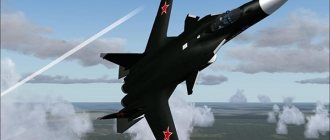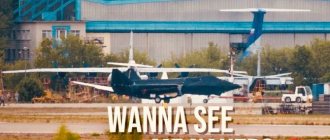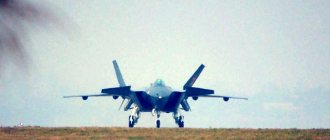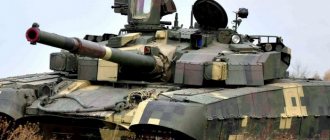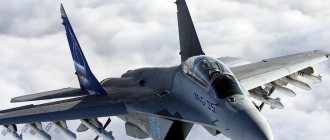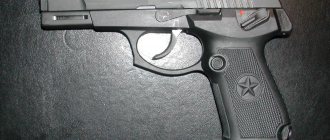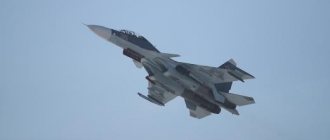Su-27
Soviet and Russian multi-role heavy supersonic fighter of the 4th generation, can be operated in any weather conditions. Designed to establish air superiority over the enemy. Used to launch missile and bomb attacks on ground targets. They also have nuclear weapons in service.
The Su-27 is not only one of the main fighters of the Russian Air Force; modifications of the aircraft are in service with the armies of China, India, and the CIS countries. Based on it, combat training, carrier-based, multi-role fighters, and bombers were produced. As of 2022, the Su-27 ranks 3rd in popularity among combat aircraft worldwide and 1st in popularity among aircraft manufactured in Russia. In service there are a maximum of 6 air-to-air missiles with radar and 2 with heat-seeking, up to 6 close-range missiles.
Sixth generation
On the Internet, no, no, yes, there is a yellow article about the sixth generation of fighters. That development is already in full swing somewhere. This is of course not true, because let us remind you that the newest fifth generation is in service only with the United States. Therefore, it is too early to talk about “development at full speed.” I should finish with the fifth one here. As for speculation about what the weapons of the future will look like, there is room for discussion. What will the new generation of aircraft be like?
From the sixth generation we can expect that all standard characteristics will increase. Speed, maneuverability. Most likely, the weight will decrease, thanks to new materials of the future, electronics will reach a new level. In the coming decades, we may expect breakthroughs in the creation of quantum computers; this will allow us to move to an unprecedented level of computing speed, which in turn will make it possible to seriously modernize the modern AI of the aircraft, which in the future may rightfully bear the name “co-pilot.” Presumably, there will be a complete abandonment of the vertical tail, which is absolutely useless in modern realities, since fighters operate mainly at extreme and extreme angles of attack. This could lead to interesting airframe shapes, perhaps again an attempt to change the wing sweep.
The most important question that future designers will decide is whether a pilot is needed at all? That is, will the fighter be controlled by AI or by a pilot, and if by a pilot, will the pilot control the plane remotely or the old-fashioned way from the cockpit. Imagine a plane without a pilot. This is a huge “relief” for the car, because in addition to the weight of the pilot himself and his equipment, a decent load is created by the pilot’s seat, which is supposed to save lives, which makes it a complex machine, stuffed with electronics and mechanisms for ejecting the pilot. Not to mention changing the design of the airframe, in which there is no need to allocate a huge amount of space for a person and rack your brains over the ergonomic design of the cockpit to make it easier to control the machine in the air. The absence of a pilot means that you no longer need to worry about overloads, which means the car can be accelerated to any speed that the structure can handle, the same goes for maneuvers in the sky. This will also make pilot training easier. And we are talking not only about reducing the requirements for the pilot’s health. Now the pilot is the most valuable thing in a fighter aircraft. Enormous amounts of time and resources are spent on preparation; the loss of a pilot is irreplaceable. If a pilot controls a fighter from a comfortable chair deep in a bunker on a military base, then this will change the face of war no less than the “transfer” from horses to tanks and infantry fighting vehicles.
The prospect of completely eliminating the pilot still looks like a task for the more distant future. Scientists are warning about the consequences of using AI, and the very philosophical and ethical component of replacing a person with a robot in war is still being studied. We still do not have the computing power to create a full-fledged replacement for the pilot, but in the coming decades a technological revolution in this area is possible. On the other hand, the pilot's flair and military ingenuity cannot be recreated by zeros and ones. For now, these are all hypotheses, so the appearance of modern aviation and the air force of the near future will still have a human face.
MiG-35
New Russian light fighter. Belongs to the 4++ generation, with characteristics as close as possible to the 5th generation. Designed to establish air superiority and use high-precision weapons to deliver effective strikes against surface and ground targets outside the enemy's air defense zone.
Entered into service in 2022. Developed by modernizing the MiG-29M/M2 and MiG-29K/KUB, the model received improved performance characteristics, increased its versatility and combat effectiveness. The aircraft has become more economical, cheaper, and stealth has improved.
Lockheed Martin F-22 Raptor
The American Lockheed Martin F-22 Raptor ranks first in the “best fighters in the world” rating. In fact, it shares the palm with the Russian Su-57. Raptor is a 5th generation fighter, presented to the public in the second half of 1990. It is capable of performing many purposes and combat missions. At the moment, the Raptor is recognized as an advanced development by American designers in this area. Among the advantages of the combat vehicle is complete invisibility from enemy radars. The Lockheed Martin F-22 Raptor is characterized as a fighter with high maneuverability, low fuel consumption and a relatively low weight. Only two cases of loss of these fighters in combat operations have been recorded.
You have already voted
MiG-31
Soviet and later Russian all-weather supersonic interceptor fighter. The first 4th generation combat aircraft of the USSR, developed back in the 1970s on the basis of the MiG-25. Unlike the prototype, the MiG-31 became a 2-seater.
The purpose of the aircraft is to intercept and destroy air targets at different altitudes, at any time of the day, in any weather conditions, when the enemy uses false thermal targets and radar interference.
A group of 4 MiG-31 units can control a significant area.
The fighter was developed to intercept aircraft missiles at any speed and altitude, to destroy low-flying satellites and drifting balloons that NATO had launched over the territory of the Soviet Union since the 50s. Armament: 6-barreled automatic cannon, with a set of 260 shells, 4 long-range guided missiles (120 km).
4. Lockheed Martin F-35 Lightning II
Another development of the US Air Force was the Lockheed Martin F-35 Lightning II, designed to replace outdated aircraft of this generation. The fighter entered service with both the US Navy and the Army - it is actively used on fleet aircraft carriers due to its short take-off run distance and braking distance during landing. Also, the Lockheed Martin F-35 Lightning II is capable of vertical takeoff. After the fighter was developed and entered into mass production, it was exported to other countries of the world, the first of which was Great Britain. The aircraft is equipped with advanced electronics and powerful weapons.
Su-35
Ultra-maneuverable multi-role fighter of the 4++ generation. One of the main aircraft of this type in the Russian Air Force. Produced by modernizing the Su-27. The differences in design with the prototype are as follows: a reinforced airframe, no brake flap and no front horizontal tail. Armament of the Su-35: aircraft cannon and 150 shells, medium-range air-to-air missiles - up to 14, short-range - 6 and long-range 4. It is armed with anti-ship air-to-ground missiles, precision-guided and unguided munitions.
Eurofighter Typhoon
The Eurofighter Typhoon combat fighter is the brainchild of four EU countries, which has proven its effectiveness in real armed conflicts. One of the main advantages of this aircraft is the ability to interfere with enemy radars, which makes it possible to adjust the flight of guided missiles. This, first of all, influenced the fact that the Eurofighter Typhoon became very “survivable” - getting into a fighter with such a system is quite difficult. The Typhoon also surpasses its counterparts in firing range (by as much as 100 km). Today there are about five hundred such fighters in the world, and each combat vehicle is manufactured using unique technology.
The best Russian fighter - Su-57
5th generation multirole fighter, developed by Russian designers as a replacement for the Su-27 heavy fighter. In 2013-2019, production of the serial aircraft began. It is planned to produce 76 units to equip 3 aviation regiments.
Information about the Su-57, for the most part, remains secret, the characteristics are known only approximately. In terms of weight, it belongs to the class of heavy fighters. The characteristics meet the requirements of the 5th generation, high stealth (a combination of Stealth electronic warfare technology is used). The Su-57 has supersonic speed and can perform maneuvers with high overloads.
It is equipped with advanced electronics and automated control. It is capable of being controlled in unmanned mode, even when far from the base, so it is being considered for the creation of new models controlled by artificial intelligence.
The Russian army is armed with several models of fighters. They differ in their characteristics, purpose, and installed weapons.
In developing
Another transition to the “five” is planned for another 4++ aircraft - the Mig-35. Sketches of the “face” of the future interceptor have already been shown, but it is not yet clear whether there will be a need for it or whether the Su-57 will cope with its functions. Not only would a light fighter meet all the requirements of the new generation, it would be necessary to develop a fundamentally new engine and solve the problem of installing stealth. Which is impossible for cars of this class in modern realities. As mentioned earlier, the fifth generation assumes the multifunctionality that the Su-57 should theoretically have, so what tasks will be assigned to the Mig is still not clear.
Another promising vehicle for the Russian aviation forces is the PAK DA, being developed within the walls of the Tupolev design bureau. From the abbreviation it is clear that we are talking about long-range aviation. According to the plan, the first flight is in 2025, but given the tendency to postpone the release of anything, you can immediately throw in a couple of three, or even five years. Therefore, most likely we will not soon see the new Tupolev take off into the sky; obviously, long-range aviation will make do with the Tu-160 and its modification in the near future.
7.McDonnell Douglas F-15 Eagle (USA)
The most successful American project of the last forty years ranks seventh in the top ten best combat fighters in the world. The F-15 Eagle is guaranteed to remain in service until 2025, which means it will have time to celebrate its fiftieth anniversary. Amazingly, over such a long period, the Eagle was defeated in an air battle only once, while destroying about a hundred enemy aircraft. This fighter is connected with the story of an Israeli Air Force pilot named Peled, who during the military conflict in Syria was able to destroy six enemy aircraft and cause significant damage to four more. Currently, six hundred F-15s are in service with various countries, and they are not going to be written off, because on average problems occur only once every 50 thousand flight hours.
Dassault Rafale
Fighter in French service, developed by Dassault Aviation. Available in three versions. It is in service with the French Air Force and Navy, and is operated in Egypt, India and Qatar. It was used in the war in Afghanistan since 2001, in the war with Libya (in 2011, small groups of fighters were involved in air patrols and also carried out combat missions - striking enemy military targets).
Dassault Rafales were used in operations against the Islamic State in 2015-2016.
J-20 (China)
Asian Dragon, another newcomer.
At first, foreign experts stated (and then Chinese state media confirmed) that the new fighter was already being actively used not only in training and testing centers, but also in combat units. It is known to be stationed in the southeastern part of the country, near the South China Sea, full of disputed islands (and foreign warships).
The appearance of a number of elements of the aircraft evoked associations in domestic patriotic circles with the MiG 1.44, an unrealized Soviet fifth-generation fighter project. However, in American circles it evoked the same associations, but with the F-22.
J-20 (photo: Ruimin YAN)
It’s simple - the Chinese carefully studied the entire world experience, and the “similarity” appeared primarily due to similar requirements. By the way, at the first demonstration of the PAK FA in the American aviation community, there was an opinion that “the damned Russians stole our YF-23.”
If everything is complicated with the origin of the J-20, then the Chinese seem to have taken the American method as an approach to development (it is now being implemented on the F-35).
We mass produce an obviously “crude” vehicle, and then master it among the troops, train the personnel and immediately catch the “bugs.”
The J-20 flew a year later than the Su-57, in 2011. But the plane is clearly still unfinished - it flies on our engines from the Su-27, and is only undergoing tests with Chinese engines.
In the coming years they promise to launch a radically modified version of the J-20B.
F-16 Fighting Falcon
Multifunctional American light fighter of the latest generation. Due to its versatility and relatively low production costs and ease of maintenance, it is considered the most widespread device of this type. By mid-2022, 4,604 examples had been produced.
The F-16 Fighting Falcon is in service in 25 countries. By 2019, the F-16 became the leader in prevalence among sick aircraft. The modernized model is still being produced for export to other countries, in particular to Slovakia, Bulgaria, Bahrain.
This is the first aircraft model designed to perform maneuvers at 9 g and fly at supersonic speeds. The design incorporates some innovations.
Saab JAS 39 Gripen
Swedish-made multi-role aircraft. Can be an attack aircraft, reconnaissance aircraft, fighter, interceptor. The aircraft has the ability to take off from insufficiently prepared airfields; a short takeoff can be used. The Saab JAS 39 Gripen is easy to maintain, simple to operate, and optimized for combat in the conditions of your country.
Saab JAS 39 Gripen are armed with the air forces of Sweden, the Czech Republic, Hungary, Thailand, and South Africa. One two-seater is used by the British ETPS flying school to train test pilots.

